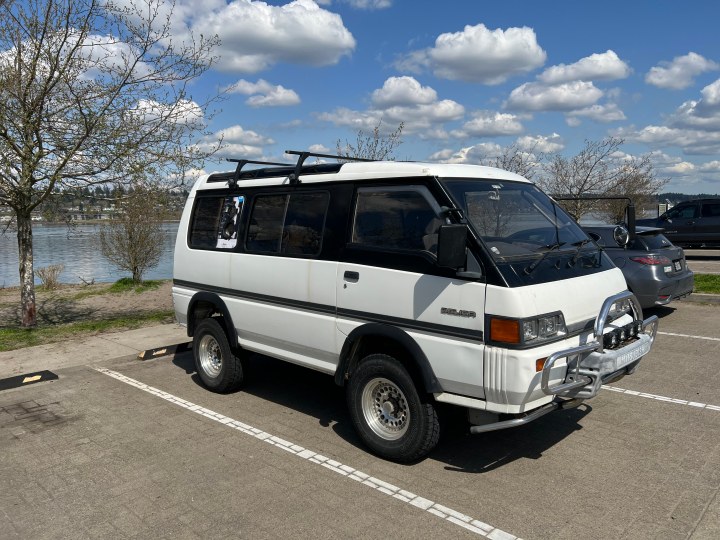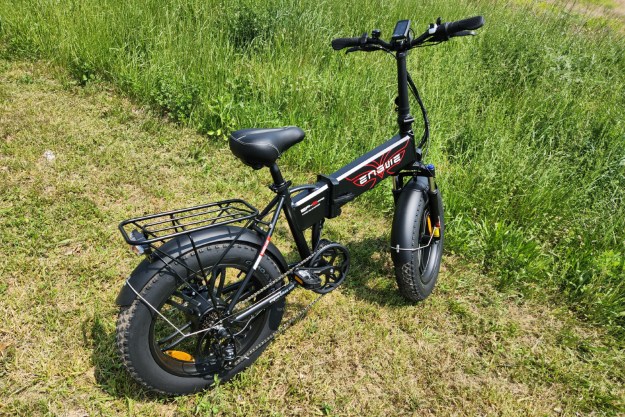Like a lot of remote workers, I know I’m lucky to be able to work from home. I have a home office with a comfy leather chair, a skylight, and an oversized doofus of a dog, Marty, who reclines adorably on the couch behind me for Zoom meetings. But I’d also be lying if I didn’t admit I go a little stir crazy from time to time, yearning to work from somewhere other than the same place I eat, sleep, and relax.
How about a van? I bought my 1990 Mitsubishi Delica for camping, but it always seemed like it could serve as a mobile office with a view, if not for one critical shortcoming: For nine months out of the year in Portland, it’s too cold, and for the other three, it’s too hot. Without adding thousands of dollars for a battery power system, my best bet was heavy socks and gloves. But EcoFlow gave me a glimmer of hope at CES 2023 when I spotted the EcoFlow Wave 2. With an onboard battery, it promised to heat or cool anywhere, no external power system needed.
So could it turn my Delica into a comfy mobile office? I welcome a good challenge, so I took my review unit and loaded it into the van, along with my laptop and a Thermos of coffee, and headed down by the river – literally – to dabble as a vanlifer.

Down by the river
Look, nobody said staying comfortable in a glass box would look cool. Since the Wave 2 needs to both draw air in and puff it out, it requires a maniacal-looking tangle of tentacles that vent to outside air to work properly. While EcoFlow includes a foam rectangle with cutouts for the tubes, it was far too small to fit my window, so I spent 30 minutes with a box cutter and gaffer tape to custom-fit some cardboard. My final install ended up looking a bit like something you would build in StarCraft.
Lest you think this janky-looking setup would alarm my beachgoing compatriots, you haven’t been to Portland recently. At the parking lot, I ended up sandwiched between a couple of biker bros who rolled up on Harley Softails to smoke weed and a blonde lady in a GMC Denali who spent the whole time shouting into her phone or flossing with her door open. Neither of them tried to tell me about their startup, so I still considered my new digs superior to a coworking space.

Reclined in my swiveling captain’s chair with a view of the Columbia River, I fired up the Wave 2 and got to work on my laptop. Though I had imagined using it in heat mode on a 58-degree spring day, the afternoon sun blasting the Delica’s greenhouse-like design left me sweltering as soon as I parked, so I flicked on the AC instead. Fifty-degree air pumped out the louvered vents in just a few minutes. To my surprise, it was so quiet, nobody even noticed on video calls.
Opening all the windows would have truthfully been a more reasonable way to keep cool, given the outside air temp, but I had committed to suffer for my gadgetry, so I sealed myself in and cranked the AC.
Though it’s rated to provide 5,100 BTU of cooling, which should really be enough for a small room, the Wave 2 struggled to keep up with the sheer amount of sunlight enveloping the van, and temperatures hovered around 78 degrees. In short sleeves, I was perfectly comfortable, but it wasn’t really what I imagined for such a cool day.
Impressive battery life
What was admirable was the battery life: Though the app predicted three hours of runtime under my nonstop use, the battery reached 1% and proceeded to inexplicably keep ticking for another 45 minutes. It was either a miracle fit for the Torah, or poor battery prediction in the app, but I have to admit I was happy for the extra time. Since I started my experiment after lunch, it got me to the end of the workday, but you’d really have to augment this thing to get eight hours of nonstop operation. The Delta Max 1600 would probably be the best pick from EcoFlow’s catalog, but any solid portable power station with over 1kWh of capacity would probably do the trick, by my estimates.
To test the heating function, I headed back out on an overcast 49-degree afternoon. My van started at 67 degrees (remember all that glass) and the Wave 2 worked its way up to 70 in less than 5 minutes of pumping out air that reached 105 degrees at the louvers. Since it was no longer fighting a relentless battle with the sun, it even managed to cycle on and off, keeping my space perfectly habitable.
We don’t yet know what the Wave 2 will cost, but considering the last-gen version goes for $1,500, we can rest assured it won’t be cheap. But there is literally nothing else like it right now. The previous-gen Wave doesn’t do heat, and any other heat pump solution would require a massive wiring project. Plus you could use this thing in a tent, a yurt, or just in place of a window air conditioner in a room that doesn’t get cold enough with your home HVAC.
After returning to a toasty warm van in a spring rainstorm, I think I could get used to this whole “van office” thing. I just need to build a bed for Marty.
Editors' Recommendations
- I tried to ruin a camping trip with 130 pounds of batteries
- GoSun’s new portable power stations use the sun’s ray to charge devices
- This portable power station has 6 AC outlets and can charge a Tesla


